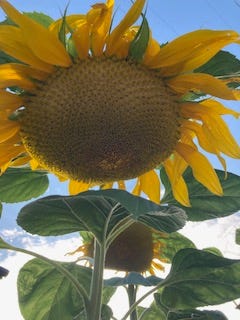Under the Sunflower
BEGINNING
In 1966, my then husband Paul and I arrived in Luxembourg to tour Europe. In a 4HP Renault station wagon, we headed southwest to Paris, renting by the Seine River near Notre Dame, and then continuing on to the English Channel, to St. Malo, for a tour of the full coast of Brittany. The Pyrenees drew us south for a cave tour (not Lascaux as that was closed), followed by our heading east toward Grasse and the Mediterranean coast. Fifty-eight years later, I have discovered that we unknowingly passed by Arles, where, at his home, Dutch painter Vincent Van Gogh painted his world-famous Sunflowers. I now consider this a major omission. In response, I'm writing about Van Gogh.
MIDDLE
In May 1888, Dutch painter Vincent Van Gogh, who chose to sign his paintings simply as Vincent, wanting to be known by his first name since he felt that French people had trouble pronouncing Van Gogh,* left Paris to move to Arles, in southern France, to establish an artists' community. Renting four rooms, he was soon joined by his friend Paul Gauguin—painter, sculptor, and writer. Vincent's hanging of a sunflower still life canvas in Gauguin's bedroom prompted his appreciation, and then knowing that he was on the right track, Vincent created a series of sunflower still life paintings that now hang in three major museums* around the world.
He wanted to be known as the painter of sunflowers, and he is—globally. Looking at my computer's view of my favorite Sunflowers still life, painted in 1889, and seen on the Van Gogh Museum site,* I listed my descriptions of Vincent's flowers.
Curious, Energetic, Alive, Independent, Excited, Enthused,
Eager, Uncombed, Unique, Adventuresome, Dance-like, Strong
Vincent said that his sunflowers symbolized "gratitude," as they are so portrayed in his triptych Woman Rocking the Cradle* that honors the comforting mother figure in the middle panel and Sunflowers as the two side panels.
END
In the first year of my relocating to America, to a small apartment on my town's boulevard, I took a daily walk on a nearby street. Each day I observed its houses, the yards, the grass... but also the plantings of bushes and flowers, and I looked to see whether there were any tricycles left on the sidewalks or, entertaining to me, any of the children’s chalk drawings. Occasionally, in passing, I would call out a "Hello." That was how I met a retired military veteran who had grown the sunflower I walked under. It was inside a white picket fence-surrounded yard of almost all flowers that showed "artistic vision” and “horticultural mastery"—descriptions I have borrowed from a garden show I once attended to give him his due. I now only occasionally walk this street; yet when I do, it is always with anticipation as I approach "Flowers Corner."
My realization is, "What appears to have been a loss from years ago, may, in time, bear fruit of full and comforting appreciation, and especially of 'gratitude.'"
* https://www.vangoghmuseum.nl/en/art-and-stories/stories/all-stories/van-goghs-letters.
* Van Gogh Museum, Amsterdam, Netherlands; Sompo Museum of Art, Tokyo, Japan; The National Gallery of London.
* https://www.vangoghmuseum.nl/en/art-and-stories/stories/all-stories/5-things-you-need-to-know-about-van-goghs-sunflowers
* Woman Rocking the Cradle, La Berceuse (Woman Rocking a Cradle; Augustine-Alix Pellicot Roulin, 1851–1930), https://www.metmuseum.org/art/collection/search/437984.

